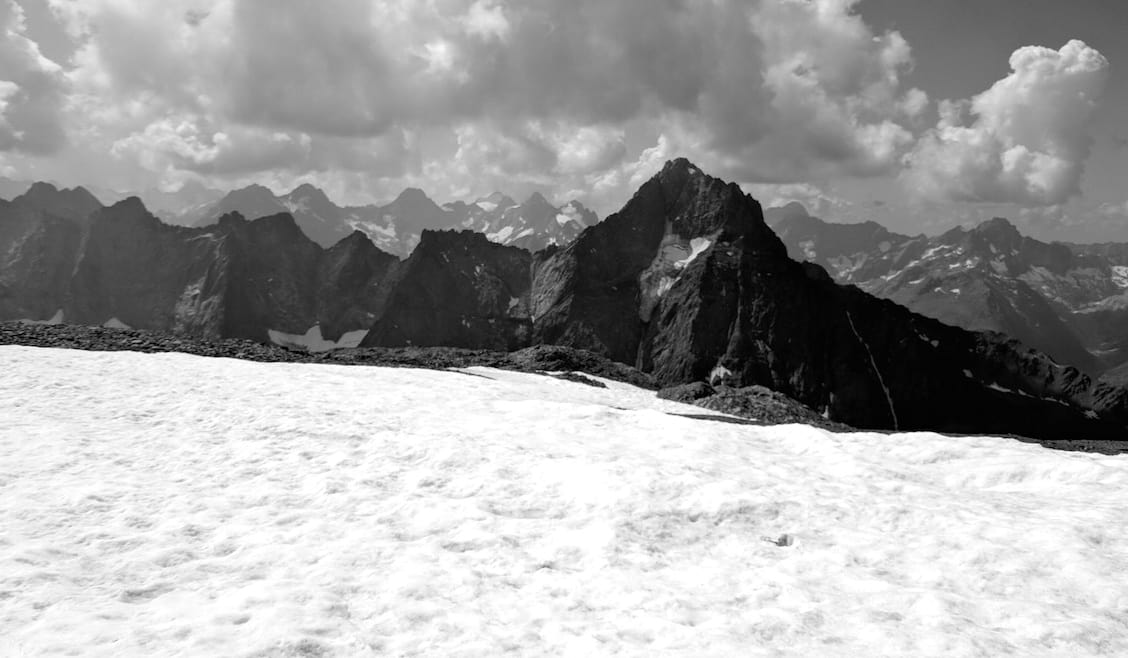The lake is clouded, an almost luminous turquoise. The bottom feels slick, like soaked wood in winter. For weeks the daytime temperature has been over twenty-five degrees yet the water is freezing, fed from the glacier above. I wade up to my waist, then dive. The shock of the cold penetrates from skin to bone. I stroke out into the middle then dive again, deep enough for the pressure to hurt my ears. Down here the sediment is so dense that I cannot see my hands. It is the kind of all-enveloping cold and blindness experienced in a snowstorm. I’m disorientated, suspended for a few seconds, not quite sure of the way back to the surface.
I’m swimming in the sky, at an elevation of 6000ft, higher than the highest point in Britain. A few hours ago I was sliding down the surface of the glacier 6000ft further up, beneath the summit of La Meije, one of the great peaks of the Alps and the last to be conquered. It was my first time on a ski slope and the sensation was similar to the frictionless glide I feel now swimming underwater.
There were few creatures up on the glacier. As we crossed ravines in the cable car I caught sight of a pair of alpine choughs. Later in the morning a golden eagle circled one of the five summits on the mountain while a bumblebee hovered low over the snow. Most of the airborne creatures I saw were humans, suspended in space, attached to skis or parasails. We come to the mountains to be birds for a time. My friend Simone, who has been on skis for most of his life, can race from the top of the glacier to the village miles below in a few minutes, a hawk-like swoop.
All summer I have been walking on a hill 1000 miles from here, a place teeming with skylarks. I watch them rise almost vertically, their wings working fast and bee-like. For a long while they hover high overhead, specks against white cloud. Then they fold and dive, allowing gravity to seize them and pull them back to earth. In the last few seconds they unfold their wings and trace a shallow arc to a perfect landing. It is a manoeuvre that reminds me of the way Simone turns to make a parallel stop, his skis carving a perfect sweeping serif in the snow. Why do skylarks make those dives? They are not chasing prey. Perhaps it’s a breeding strategy, a daredevil stunt to impress a mate. Perhaps it is intrinsic, for the sake of the dive, a learned-in-the-bone act of creaturely joy.
Halfway down the dive is when we are living to the full. Suspended between two points, letting go of one trapeze and reaching for the other. For the skier it’s halfway down the slope. For the artist it’s the point when the image has lost its initial shape and a finished form has not quite come into view. Halfway is the point when we think we might run out of oxygen.
Half a lifetime ago I remember coming to the side of a lake the colour of this one, stained with a tropical algae, surrounded by boulders and cropped turf. It was a hot day like this, the water cool and inviting. Near the water’s edge was a thorn tree with a wide, tangled crown and beneath it, in dense shade, a lone lioness. My heart rate doubled. My guide was unconcerned. He pointed to the lioness’s distended stomach and the big cat’s dog-like panting. It had recently been on a hunt and had eaten so much meat that it wouldn’t be able to move for a long time. As I took this in the fear left me. The lion was diminished. It lay there half invisible as other animals came to the water showing no fear, knowing that, unable to hunt, the lion was not really a lion. A few hours before it would have been entirely different, a ravenous thing, pushing itself to the limit of its abilities, caught halfway between bloodlust and the threat of death from the giraffe the pride eventually killed. A long time ago we humans hunted similarly to this, bringing down dangerous prey, forced to push ourselves fully to the limits of our cunning and strength.
We are millennia beyond our hunting ancestors and down the long slide of time since we’ve found new ways to be fully ourselves. We climb and we dive. We’ve discovered ways to fly with and without wings, ways to achieve a disappearing act through the practise of an art, methods to create the in-betweenness. The constants in these activities are threat of failure and fear of the unknown which have to be held and then released like precious birds. We accelerate somehow, and the world becomes a blur that we are only partly aware of. Time stretches into non-linear shapes and we’re weightless, diving down into the ice blue.
I’m at the halfway point, not able to swim any deeper, half out of breath. The initial shock of the cold has faded, replaced by an electric current which is trickling from my fingers and toes towards my solar plexus. When I rise and breathe again, I’ll be filled with a charge which will carry me, away from the water, down the mountain.

